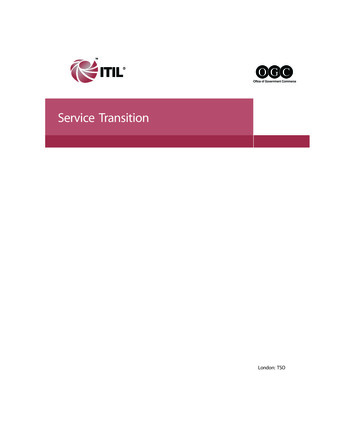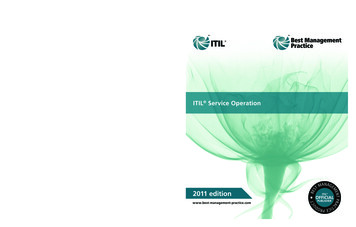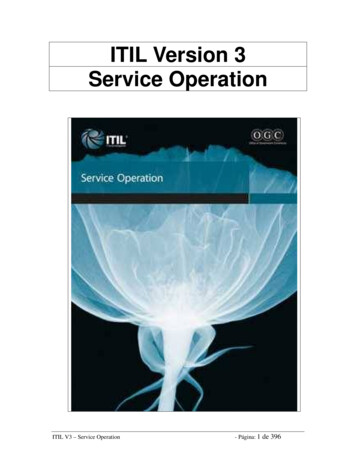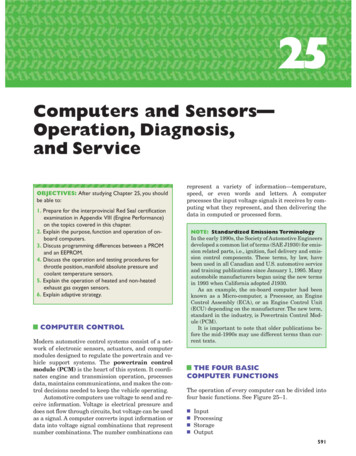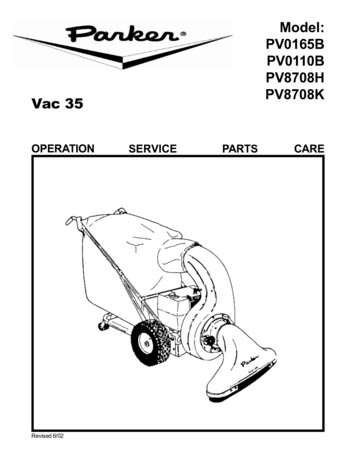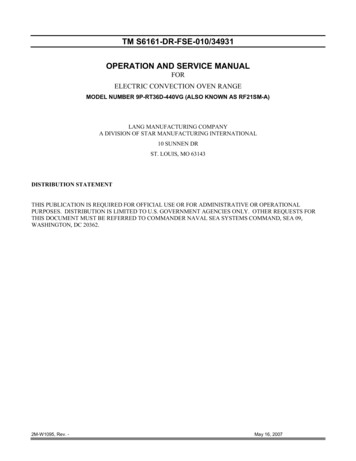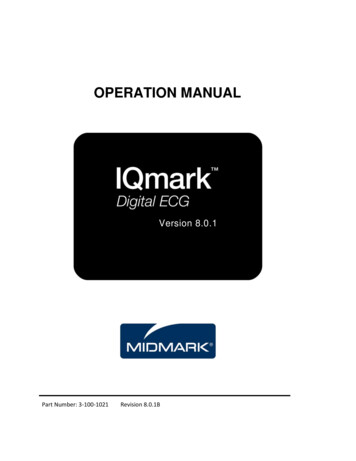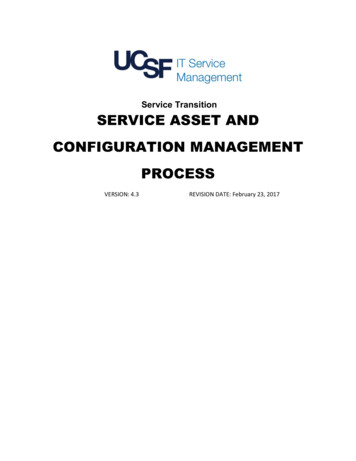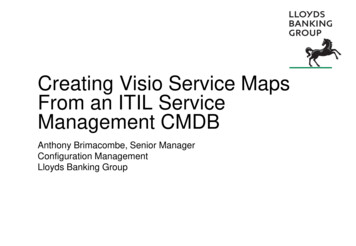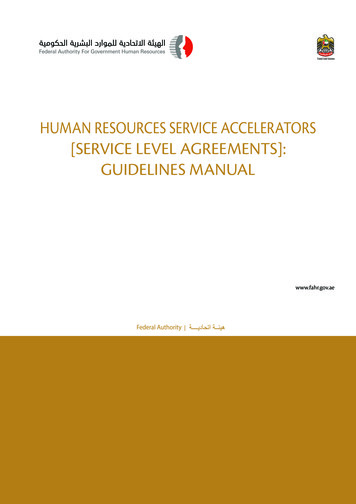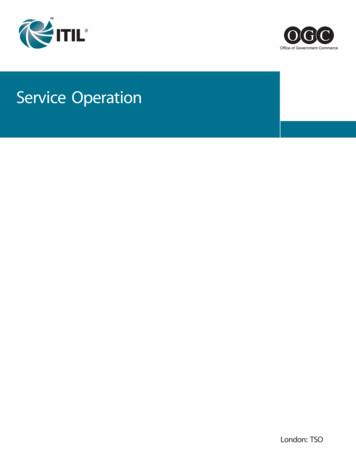
Transcription
Service OperationLondon: TSO
Published by TSO (The Stationery Office) and available from:Onlinewww.tsoshop.co.ukMail,Telephone, Fax & E-mailTSOPO Box 29, Norwich, NR3 1GNTelephone orders/General enquiries: 0870 600 5522Fax orders: 0870 600 5533E-mail: customer.services@tso.co.ukTextphone 0870 240 3701TSO Shops123 Kingsway, London,WC2B 6PQ020 7242 6393 Fax 020 7242 639416 Arthur Street, Belfast BT1 4GD028 9023 8451 Fax 028 9023 540171 Lothian Road, Edinburgh EH3 9AZ0870 606 5566 Fax 0870 606 5588TSO@Blackwell and other Accredited AgentsPublished for the Office of Government Commerce under licence from the Controller of Her Majesty’sStationery Office. Crown Copyright 2007This is a Crown copyright value added product, reuse of which requires a Click-Use Licence for valueadded material issued by OPSI.Applications to reuse, reproduce or republish material in this publication should be sent to OPSI,Information Policy Team, St Clements House, 2-16 Colegate, Norwich, NR3 1BQ,Tel No (01603) 621000 Fax No (01603) 723000, E-mail: hmsolicensing@cabinet-office.x.gsi.gov.uk, orcomplete the application form on the OPSI website ceinformation/index.htmOPSI, in consultation with Office of Government Commerce (OGC), may then prepare a Value AddedLicence based on standard terms tailored to your particular requirements including payment termsThe OGC logo is a Registered Trade Mark of the Office of Government CommerceITIL is a Registered Trade Mark, and a Registered Community Trade Mark of the Office of GovernmentCommerce, and is Registered in the U.S. Patent and Trademark OfficeThe Swirl logo is a Trade Mark of the Office of Government CommerceFirst published 2007ISBN 978 0 11 331046 3Printed in the United Kingdom for The Stationery Office
iii ContentsList of figuresvList of tablesviOGC’s forewordviiChief Architect’s forewordviii54.4Problem Management584.5Access Management684.6Operational activities of processescovered in other lifecycle phases72Common Service Operation activities795.1Monitoring and control825.2IT Operations92PrefaceixAcknowledgementsx5.3Mainframe Management951Introduction15.4Server Management and Support951.1 Overview35.5Network Management961.2Context35.6Storage and Archive971.3Purpose75.7Database Administration971.4Usage75.8Directory Services Management981.5Chapter overview75.9Desktop Support982Service Management as a practice92.1What is Service Management?112.2What are services?112.3Functions and processes across thelifecycle12Service Operation fundamentals132.463Service Operation principles3.1417Functions, groups, teams, departmentsand divisions193.2Achieving balance in Service Operation193.3Providing service283.4Operation staff involvement in ServiceDesign and Service Transition283.5Operational e Operation processes334.1Event Management354.2Incident Management464.3Request Fulfilment555.10 Middleware Management995.11 Internet/Web Management995.12 Facilities and Data Centre Management1005.13 Information Security Management andService Operation1015.14 Improvement of operational activities102Organizing for Service Operation6.1Functions1076.2Service Desk1096.3Technical Management1216.4IT Operations Management1256.5Application Management1286.6Service Operation roles andresponsibilities1406.77105Service Operation Organization Structures 146Technology considerations1557.1Generic requirements1577.2Event Management1587.3Incident Management1597.4Request fulfilment1597.5Problem Management159
iv 87.6Access Management1607.7Service Desk160C1Defining the problem201163C2Describing the problem201C3Establishing possible causes201C4Testing the most probable cause201C5Verifying the true cause201Implementing Service OperationManaging change in Service Operation8.2Service Operation and ProjectManagement165Assessing and managing risk in ServiceOperation166Appendix D: Ishikawa Diagrams203Operational staff in Service Design andTransition166Appendix E: Detailed description ofFacilities Management207Planning and Implementing ServiceManagement technologies1668.48.591998.18.3Challenges, Critical Success Factorsand risks165Appendix C: Kepner and Tregoe169E1Building Management209E2Equipment Hosting209E3Power Management210E4Environmental Conditioning andAlert Systems2109.1Challenges1719.2Critical Success Factors173E5Safety2119.3Risks175E6Physical Access Control211E7Shipping and Receiving212E8Involvement in Contract Management212E9Maintenance212AfterwordAppendix A: Complementary industryguidance177181A1COBIT183Appendix F: Physical Access Control213A2ISO/IEC 20000183Glossary219A3CMMI184A4Balanced Scorecard184A5Quality Management184A6ITIL and the OSI Framework184Appendix B: Communication in ServiceOperation185B1Routine operational communication187B2Communication between shifts188B3Performance Reporting189B4Communication in projects192B5Communication related to changes194B6Communication related to exceptions195B7Communication related to emergencies196B8Communication with users and customers 197Acronyms list221Definitions list223Index251
List of figuresAll diagrams in this publication are intended to provide anillustration of ITIL Service Management Practice conceptsand guidance. They have been artistically rendered tovisually reinforce key concepts and are not intended tomeet a formal method or standard of technical drawing.The ITIL Service Management Practices Integrated ServiceModel conforms to technical drawing standards andshould be referred to for complete details. Please seewww.best-management-practice.com/itil for details.Figure 1.1Source of Service Management PracticeFigure 1.2ITIL CoreFigure 2.1A conversation about the definition andmeaning of servicesFigure 2.2A basic processFigure 3.1Achieving a balance between external andinternal focusFigure 3.2Achieving a balance between focus onstability and responsivenessFigure 3.3Balancing service quality and costFigure 3.4Achieving a balance between focus on costand qualityFigure 3.5Achieving a balance between being tooreactive or too proactiveFigure 4.1The Event Management processFigure 4.2Incident Management process flowFigure 4.3Multi-level incident categorizationFigure 4.4Problem Management process flowFigure 4.5Important versus trivial causesFigure 4.6Service Knowledge Management SystemFigure 5.1Achieving maturity in TechnologyManagementFigure 5.2The Monitor Control LoopFigure 5.3Complex Monitor Control LoopFigure 5.4ITSM Monitor Control LoopFigure 6.1Service Operation functionsFigure 6.2Local Service DeskFigure 6.3Centralized Service DeskFigure 6.4Virtual Service DeskFigure 6.5Application Management LifecycleFigure 6.6Role of teams in the Application ManagementLifecycleFigure 6.7IT Operations organized according totechnical specialization (sample)Figure 6.8A department based on executing a set ofactivitiesFigure 6.9IT Operations organized according togeographyFigure 6.10 Centralized IT Operations, Technical andApplication Management structureFigure D.1 Sample of starting an Ishikawa DiagramFigure D.2 Sample of a completed Ishikawa Diagramv
vi List of tablesTable 3.1Examples of extreme internal and externalfocusTable 3.2Examples of extreme focus on stability andresponsivenessTable 3.3Examples of extreme focus on quality andcostTable 3.4Examples of extremely reactive and proactivebehaviourTable 4.1Simple priority coding systemTable 4.2Pareto cause ranking chartTable 5.1Active and Passive Reactive and ProactiveMonitoringTable 6.1Survey techniques and toolsTable 6.2Organizational rolesTable B.1Communication requirements in IT servicesTable B.2Communication requirements between shiftsTable B.3Performance Reporting requirements: ITserviceTable B.4Performance Reporting requirements: ServiceOperation team or departmentTable B.5Performance Reporting requirements:infrastructure or processTable B.6Communication within projectsTable B.7Communication on handover of projectsTable B.8Communication about changesTable B.9Communication during exceptionsTable B.10 Communication during emergenciesTable B.11 Communication with users and customersTable F.1Access control devices
OGC’s forewordSince its creation, ITIL has grown to become the mostwidely accepted approach to IT service management inthe world. However, along with this success comes theresponsibility to ensure that the guidance keeps pace witha changing global business environment. Servicemanagement requirements are inevitably shaped by thedevelopment of technology, revised business models andincreasing customer expectations. Our latest version of ITILhas been created in response to these developments.This is one of the five core publications describing the ITservice management practices that make up ITIL. They arethe result of a two-year project to review and update theguidance. The number of service managementprofessionals around the world who have helped todevelop the content of these publications is impressive.Their experience and knowledge have contributed to thecontent to bring you a consistent set of high-qualityguidance. This is supported by the ongoing developmentof a comprehensive qualifications scheme, along withaccredited training and consultancy.Whether you are part of a global company, a governmentdepartment or a small business, ITIL gives you access toworld-class service management expertise. Essentially, itputs IT services where they belong – at the heart ofsuccessful business operations.Peter FanningActing Chief ExecutiveOffice of Government Commercevii
viii Chief Architect’s forewordITIL Service Management Practice guidance is structuredaround the Service Lifecycle. Common across the lifecycleis the overall practice itself, which relies on processes,functions, activities, organizational models andmeasurement, which together allow IT ServiceManagement (ITSM) to integrate with the businessprocesses, provide measurable value and evolve the ITSMindustry forward in our pursuit of service excellence.Nowhere else in the ITIL Service Lifecycle does the effectof how we perform as service providers touch thecustomers as intimately as Service Operations. This iswhere the strategy, design, transition and improvementsare delivered and supported on a day-to-day basis.The Service Operation publication brings ServiceManagement to life for the business, and theaccountability for the performance of the services, thepeople who create them and the technology that enablesthem are monitored, controlled and delivered in this stageof the Service Lifecycle.This publication will help guide us all to achieve serviceexcellence and to see the value of ITSM in a broad,business-focused view of it. Whether you are new to thepractice of ITIL or a seasoned practitioner, the guidance inthis publication will expand your vision and knowledge ofhow to be the best-of-breed service provider throughimplementation of Service Operation.There is a saying that hindsight is 20/20. The guidance inService Operation is distilled from over 20 years ofexperience in ITSM by world experts, business people andITSM practitioners and the lessons learned by them aboutwhat service excellence really is and how to achieve it.Anyone involved in operating services will benefit fromthe guidance in the following pages of this publication.Service Operation offers the best advice and guidancefrom around the world and a path to what is possible inyour future.Sharon TaylorChief Architect, ITIL Service Management Practices
PrefaceThis publication encompasses and supersedes theoperational aspects of the ITIL Service Support and ServiceDelivery publications and also covers most of the scope ofICT infrastructure Management. It also incorporatesoperational aspects from the Planning to Implement,Application Management, Software Asset Managementand Security Management publications.The basic principles of best practice IT servicemanagement encompassed within earlier versions ofITIL remain unchanged. Common sense remainscommon sense!However, the technologies, tools and relationshipshave changed significantly, even in the relatively shorttime since the latest version of ITIL was completed. Whilstthis publication re-uses and updates relevant materialfrom the earlier versions where appropriate, it alsoincludes many new concepts and industry practices togive complete coverage of best-practice guidance fortoday’s Service Operation in a single volume, for today’sbusiness and technological environment.Contact informationFull details of the range of material published under theITIL banner can be found atwww.best-management-practice.com/itilFor further information on qualifications and trainingaccreditation, please visit www.itil-officialsite.com.Alternatively, please contact:APMG Service DeskSword HouseTotteridge RoadHigh WycombeBuckinghamshireHP13 6DGTel: 44 (0) 1494 452450E-mail: servicedesk@apmg.co.ukix
x AcknowledgementsChief Architect and authorsSharon Taylor(Aspect Group Inc)Chief ArchitectDavid Cannon (HP)AuthorDavid Wheeldon (HP)AuthorITIL authoring teamThe ITIL authoring team contributed to this guide throughcommenting on content and alignment across the set. Sothanks are also due to the other ITIL authors, specificallyJeroen Bronkhorst (HP), Gary Case (Pink Elephant), AshleyHannah (HP), Majid Iqbal (Carnegie Mellon University),Shirley Lacy (ConnectSphere), Vernon Lloyd (Fox IT), IvorMacfarlane (Guillemot Rock), Michael Nieves (Accenture),Stuart Rance (HP), Colin Rudd (ITEMS) and GeorgeSpalding (Pink Elephant).MentorsChristian Nissen and Paul Wilkinson.Further contributionsA number of people generously contributed their timeand expertise to this Service Operation publication. JimClinch, as OGC Project Manager, is grateful for the supportprovided by HP to the authoring team on thedevelopment of this publication and particularly thecontribution of Peter Doherty and Robert Stroud, and forthe support of Jenny Dugmore, Convenor of WorkingGroup ISO/IEC 20000, Janine Eves, Carol H
Service Operation 101 5.14 Improvement of operational activities 102 6 Organizing for Service Operation 105 6.1 Functions 107 6.2 Service Desk 109 6.3 Technical Management 121 6.4 IT Operations Management 125 6.5 Application Management 128 6.6 Service Operation roles and responsibilities 140 6.7 Service Operation Organization Structures 146
